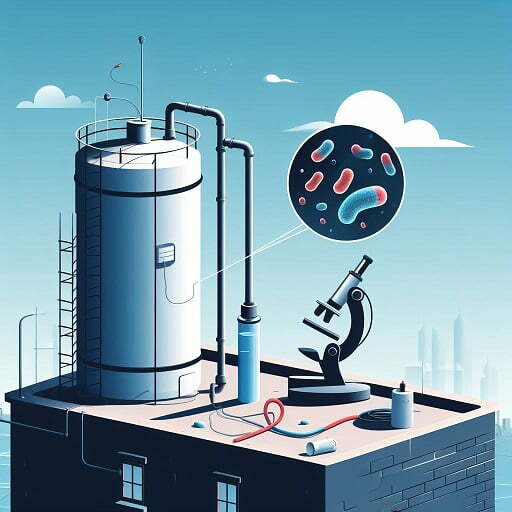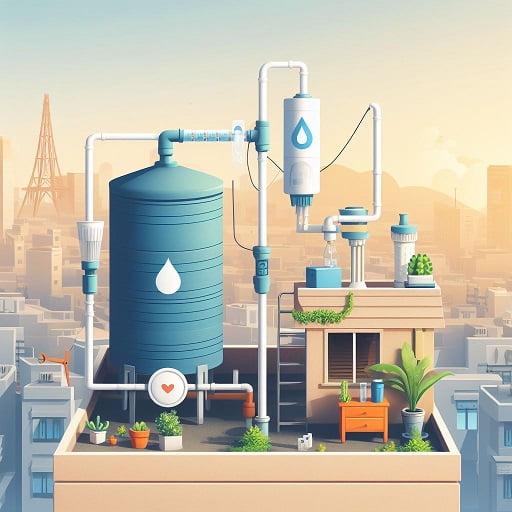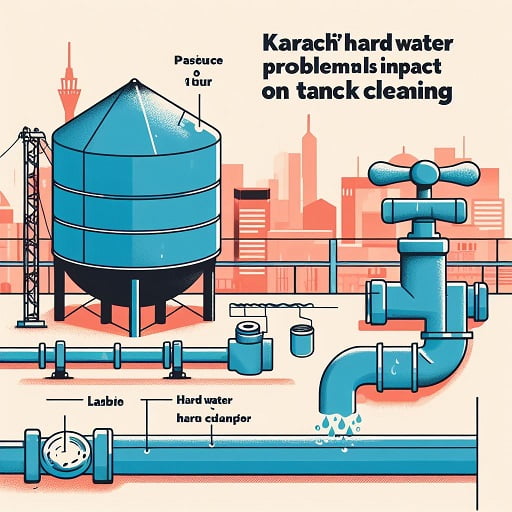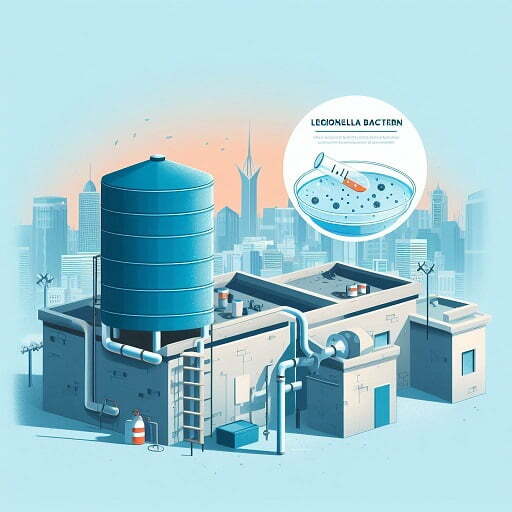Water tanks are essential for storing and supplying water to households, businesses, and communities in Karachi. However, water tanks can also harbor bacteria that can contaminate the water and pose serious health risks to the residents. This article aims to provide an overview of the types, sources, and effects of bacterial contamination in Karachi’s water tanks, as well as the methods and strategies to prevent and control it.
Understanding Bacteria in Karachi’s Water Tanks
Bacteria are microscopic organisms that can be found in various environments, including water. Some bacteria are beneficial and harmless, while others are harmful and pathogenic. Pathogenic bacteria can cause infections and diseases in humans and animals.
Types of Bacteria Found
There are many types of bacteria that can be found in water tanks, but some of the most common ones are:
- Coliform bacteria: These are a group of bacteria that indicate the presence of fecal contamination in water. They include Escherichia coli (E. coli), which can cause diarrhea, vomiting, fever, and abdominal cramps.
- Legionella bacteria: These are a group of bacteria that can cause legionellosis, a respiratory disease that can range from mild flu-like symptoms to severe pneumonia and death. Legionella bacteria grow best in warm water and can be transmitted through inhalation of aerosols or droplets from water sources such as showers, faucets, or cooling towers.
- Pseudomonas aeruginosa: This is a type of bacteria that can cause various infections, especially in people with weakened immune systems or chronic conditions. It can affect the skin, eyes, ears, lungs, urinary tract, and blood. Pseudomonas aeruginosa can also produce a biofilm, which is a slimy layer that protects the bacteria from disinfectants and antibiotics.
Sources of Bacterial Contamination
Bacterial contamination in water tanks can originate from various sources, such as:
- Environmental factors: These include natural sources of bacteria such as soil, plants, animals, or insects. For example, birds or rodents can introduce fecal matter or carcasses into water tanks. Rainwater or runoff can also carry bacteria from the surroundings into water tanks.
- Human activities: These include activities that introduce bacteria into water tanks through direct or indirect contact. For example, people can contaminate water tanks by using dirty tools or equipment, touching or drinking from the tank outlets, or disposing of waste or sewage near the tank. Cross-contamination can also occur when water pipes or hoses are connected to different sources of water without proper disinfection.
Health Risks Associated with Bacterial Contamination
Bacterial contamination in water tanks can pose serious health risks to the residents who use the water for drinking, cooking, washing, or bathing. Some of the health risks are:
- Waterborne diseases: These are diseases that are caused by ingesting or coming into contact with contaminated water. They include diarrhea, dysentery, typhoid fever, cholera, hepatitis A, leptospirosis, and salmonellosis. Waterborne diseases can lead to dehydration, malnutrition, organ failure, or death.
- Health impacts on residents: These are the effects that bacterial contamination can have on the health and well-being of the residents. They include reduced immunity, increased susceptibility to infections, impaired growth and development, decreased productivity and performance, increased medical expenses, and reduced quality of life.
Bacterial Contamination Assessment
To prevent and control bacterial contamination in water tanks, it is important to assess the quality of the water regularly. This can be done by:
Water Testing and Analysis
Water testing and analysis are methods of measuring and identifying the presence and level of bacteria in water samples. They are essential for ensuring the safety and suitability of the water for its intended use.
Importance of Regular Testing
Regular testing is important for detecting any changes or problems in the water quality before they become serious or irreversible. Regular testing can also help monitor the effectiveness of preventive measures or treatment methods applied to the water.
Common Testing Methods
Some of the common testing methods for bacterial contamination are:
- Membrane filtration: This method involves filtering a known volume of water through a membrane filter that traps bacteria on its surface. The filter is then placed on a culture medium that allows the bacteria to grow and form colonies that can be counted under a microscope.
- Most probable number (MPN): This method involves adding measured amounts of water to tubes containing a liquid culture medium that supports bacterial growth. The tubes are then incubated at a specific temperature for a certain period of time. The number of tubes that show signs of bacterial growth, such as turbidity or color change, is used to estimate the number of bacteria in the water sample.
- Colilert test: This is a rapid and simple test that uses a powder reagent that changes color or fluoresces when exposed to coliform bacteria or E. coli in water. The reagent is added to a water sample and incubated for 24 hours. The presence and concentration of bacteria are indicated by the color or fluorescence of the sample.
Identifying Contaminated Water
Identifying contaminated water is a way of recognizing the signs and symptoms that indicate bacterial contamination in water tanks. It can help alert the residents to take precautionary measures or seek medical attention.
Signs and Symptoms
Some of the signs and symptoms of contaminated water are:
- Odor: Contaminated water may have a foul or unpleasant smell, such as rotten eggs, sewage, or chlorine.
- Color: Contaminated water may have a cloudy, murky, or discolored appearance, such as brown, yellow, green, or red.
- Taste: Contaminated water may have a bitter, metallic, or sour taste, such as iron, copper, or vinegar.
- Illness: Contaminated water may cause illness in people who consume or use it, such as fever, nausea, vomiting, diarrhea, abdominal pain, headache, or skin rash.
Laboratory Confirmation
Laboratory confirmation is a way of verifying the presence and type of bacteria in water samples using scientific methods and equipment. It can help confirm the diagnosis and treatment of waterborne diseases.
Some of the laboratory methods for confirming bacterial contamination are:
- Gram staining: This is a method of staining bacteria with different dyes to distinguish them based on their cell wall structure. Gram-positive bacteria retain a purple color, while gram-negative bacteria lose the purple color and appear pink.
- Biochemical tests: These are tests that use different substances or chemicals to detect the metabolic reactions or enzymes of bacteria. For example, the indole test uses Kovac’s reagent to detect the production of indole by bacteria that break down tryptophan.
- Molecular tests: These are tests that use DNA or RNA techniques to identify the genetic material or sequences of bacteria. For example, the polymerase chain reaction (PCR) test uses primers and probes to amplify and detect specific DNA fragments of bacteria.
Factors Contributing to Bacterial Growth
Bacterial growth is the process of bacteria multiplying and increasing in number and size. Bacterial growth in water tanks can be influenced by various factors, such as:
Stagnant Water
Stagnant water is water that does not flow or circulate. Stagnant water can promote bacterial growth by:
- Providing nutrients: Stagnant water can accumulate organic matter or debris that can serve as food sources for bacteria.
- Reducing oxygen: Stagnant water can have low levels of dissolved oxygen that can favor anaerobic bacteria that do not need oxygen to survive.
- Increasing pH: Stagnant water can have high levels of carbon dioxide that can lower the pH and create acidic conditions that can favor some types of bacteria.
Temperature and Climate
Temperature and climate are the measures of heat and weather conditions. Temperature and climate can affect bacterial growth by:
- Optimizing growth rate: Temperature and climate can determine the optimal growth rate of bacteria by affecting their metabolic activity and enzyme function. Most bacteria grow best at moderate temperatures between 20°C and 40°C. However, some bacteria can grow at extreme temperatures such as thermophiles (above 45°C) or psychrophiles (below 15°C).
- Varying seasonally: Temperature and climate can vary seasonally and create fluctuations in bacterial growth. For example, bacterial growth can increase during summer when the temperature is high and decrease during winter when the temperature is low.
Poor Maintenance
Poor maintenance is the lack of proper care or upkeep of water tanks. Poor maintenance can contribute to bacterial growth by:
- Allowing accumulation: Poor maintenance can allow the accumulation of dirt, dust, rust, algae, biofilm, sediment, or other contaminants that can provide nutrients and shelter for bacteria.
- Creating leaks or cracks: Poor maintenance can create leaks or cracks in the water tank structure that can allow the entry of bacteria from external sources or the escape of water from internal sources.
- Reducing disinfection: Poor maintenance can reduce the effectiveness or frequency of disinfection methods applied to the water tank such as chlorination or UV treatment.
Preventive Measures to Combat Bacterial Contamination
Bacterial contamination in water tanks can be prevented and controlled by implementing various measures, such as:
- Regular Cleaning and Maintenance: This is the most basic and essential measure to keep water tanks clean and free from bacteria. Regular cleaning and maintenance involve:
- Cleaning guidelines: Water tanks should be cleaned at least once a year or more frequently depending on the water quality and usage. Cleaning should be done by trained professionals or qualified personnel who can follow proper procedures and safety precautions. Cleaning should include removing any dirt, dust, rust, algae, biofilm, sediment, or other contaminants from the tank walls, floor, ceiling, and fittings. Cleaning should also include disinfecting the tank with chlorine or other suitable agents to kill any remaining bacteria.
- Scheduling maintenance: Water tanks should be maintained regularly to ensure their optimal function and performance. Maintenance should include checking and repairing any leaks, cracks, or damages in the tank structure or components. Maintenance should also include replacing or upgrading any worn-out or outdated parts or equipment such as valves, pipes, hoses, filters, or pumps.
- Water Disinfection Techniques: These are methods of killing or inactivating bacteria in water using chemical or physical agents. Water disinfection techniques include:
- Chlorination: This is the most common and widely used method of water disinfection. Chlorination involves adding chlorine or chlorine compounds to water to destroy bacteria and other microorganisms. Chlorine can be added in different forms such as gas, liquid, powder, or tablet. Chlorine can also be generated on-site using electrolysis or solar power. Chlorination can be done at different points of the water supply system such as the source, the treatment plant, the distribution network, or the point of use.
- UV Treatment: This is a method of water disinfection that uses ultraviolet (UV) light to damage the DNA of bacteria and prevent them from reproducing. UV treatment involves exposing water to UV lamps that emit UV rays of a specific wavelength and intensity. UV treatment can be done at the point of use using portable or fixed devices that can be installed on faucets, showers, or tanks.
- Filtering and Purification: These are methods of removing bacteria and other impurities from water using physical or mechanical processes. Filtering and purification include:
- Use of water filters: Water filters are devices that trap or block bacteria and other contaminants from passing through them. Water filters can be made of different materials such as sand, gravel, charcoal, ceramic, paper, cloth, or metal. Water filters can have different pore sizes that determine the size of particles they can remove. Water filters can be used at different points of the water supply system such as the source, the treatment plant, the distribution network, or the point of use.
- Importance of filtration: Filtration is important for improving the quality and safety of water by reducing the turbidity, color, odor, taste, and bacterial load of water. Filtration can also enhance the effectiveness of disinfection methods by removing organic matter that can interfere with chlorine or UV treatment.
- Promoting Hygiene and Safe Water Practices: These are methods of raising awareness and educating residents about the importance and benefits of hygiene and safe water practices. Promoting hygiene and safe water practices include:
- Educating residents: Residents should be informed about the sources, effects, and prevention of bacterial contamination in water tanks. Residents should also be taught how to use and maintain water tanks properly and safely. Residents should also be encouraged to adopt hygienic habits such as washing hands with soap and water before handling water, storing water in clean and covered containers, boiling or treating water before drinking or cooking, and disposing of waste or sewage away from water sources.
- Community initiatives: Community initiatives are actions taken by groups of residents or organizations to improve the water quality and sanitation in their area. Community initiatives can include forming water committees or groups that can oversee and manage the water supply system, conducting regular water testing and monitoring, organizing cleaning and maintenance campaigns, installing or distributing water filters or disinfection devices, providing health education or counseling services, or lobbying for government support or intervention.
Government and Municipal Efforts
Bacterial contamination in water tanks can also be addressed by the government and municipal authorities who are responsible for regulating and managing the public water supply system. Government and municipal efforts include:
- Regulatory framework: This is the set of laws, policies, standards, guidelines, and procedures that govern the provision and quality of water services. Regulatory framework includes:
- Government policies: These are the plans and strategies that outline the goals and objectives of the government regarding the water sector. Government policies can include national or regional plans for water resource management, conservation, development, allocation, distribution, pricing, and quality control.
- Legal requirements: These are the rules and regulations that specify the obligations and responsibilities of the water service providers and consumers. Legal requirements can include licensing or registration of water operators, monitoring or reporting of water quality, enforcement or penalties for non-compliance, or dispute resolution or grievance mechanisms.
- Municipal initiatives: These are the actions and programs that are implemented by the municipal authorities to improve the water supply and sanitation in their jurisdiction. Municipal initiatives can include:
- Water quality standards: These are the criteria or limits that define the acceptable level of bacteria and other contaminants in water. Water quality standards can be based on national or international guidelines such as the World Health Organization (WHO) or the Pakistan Council of Research in Water Resources (PCRWR). Water quality standards can also vary depending on the intended use of water such as drinking, domestic, industrial, or agricultural.
- Water supply management: This is the process of planning, operating, maintaining, and upgrading the water supply system. Water supply management can include assessing the water demand and availability, designing and constructing the water infrastructure, ensuring the reliability and efficiency of the water delivery, protecting and conserving the water resources, or responding to emergencies or disruptions.
Case Studies and Success Stories
Bacterial contamination in water tanks can be effectively controlled by learning from the experiences and best practices of other communities or organizations that have successfully tackled this issue. Case studies and success stories can include:
- Examples of effective bacterial contamination control: These are examples of projects or interventions that have achieved positive results in reducing or eliminating bacterial contamination in water tanks. Examples can include:
- The Karachi Water Partnership (KWP): This is a public-private partnership that aims to improve the water governance and management in Karachi. One of its initiatives is the Water Conservation Campaign, which involves conducting awareness sessions, distributing water conservation kits, installing water meters, and promoting rainwater harvesting among schools, communities, and industries. The campaign has helped save over 1 billion liters of water and reduce bacterial contamination by 50% in some areas.
- The Orangi Pilot Project (OPP): This is a community-based organization that works to improve the living conditions and sanitation in Orangi Town, one of the largest slums in Karachi. One of its activities is the Low-Cost Sanitation Program, which involves providing technical guidance, material support, and financial assistance to residents to build their own sewerage systems, latrines, and water tanks. The program has helped construct over 100,000 latrines and 10,000 water tanks, resulting in improved hygiene and reduced bacterial contamination.
- Community efforts and collaborations: These are efforts and collaborations that involve the participation and cooperation of different stakeholders such as residents, water operators, NGOs, government agencies, or donors to address bacterial contamination in water tanks. Community efforts and collaborations can include:
- The Karachi Water Tanker Mafia (KWTM): This is a network of informal water suppliers that operate private water tankers to deliver water to areas that lack access to piped water. The KWTM has been accused of exploiting the water scarcity situation by charging exorbitant prices, delivering contaminated water, or creating artificial shortages. To counter this problem, some communities have formed their own associations or cooperatives to regulate the water tanker services, negotiate fair prices, monitor water quality, or establish alternative sources of water.
- The Citizens-Police Liaison Committee (CPLC): This is a joint venture between the citizens and the police that aims to improve the law enforcement and security situation in Karachi. One of its functions is to provide a helpline service for citizens to report any complaints or grievances related to various issues such as crime, corruption, or public services. The CPLC has also been involved in resolving disputes or conflicts related to water supply or quality among different parties such as residents, water operators, or municipal authorities.
- Lessons learned from past experiences: These are lessons learned from past experiences that can provide insights and guidance for future actions or improvements regarding bacterial contamination in water tanks. Lessons learned can include:
- The importance of community involvement: Community involvement is crucial for ensuring the success and sustainability of any project or intervention related to bacterial contamination in water tanks. Community involvement can increase the ownership, accountability, and responsibility of the stakeholders involved. Community involvement can also enhance the trust, communication, and coordination among different actors. Community involvement can be achieved by engaging the residents in the planning, implementation, monitoring, and evaluation of the project or intervention, as well as providing them with training, education, or incentives to participate.
- The importance of integrated approaches: Integrated approaches are approaches that consider and address the multiple dimensions and factors that affect bacterial contamination in water tanks. Integrated approaches can improve the effectiveness and efficiency of the project or intervention by avoiding duplication, fragmentation, or contradiction of efforts. Integrated approaches can also improve the adaptability and resilience of the project or intervention by responding to changing needs, conditions, or challenges. Integrated approaches can be achieved by collaborating and coordinating with different sectors, disciplines, or stakeholders that are relevant to the issue of bacterial contamination in water tanks, such as health, environment, education, or governance.
- The importance of innovation and technology: Innovation and technology are tools that can facilitate and enhance the project or intervention related to bacterial contamination in water tanks. Innovation and technology can improve the quality and accessibility of the water services by introducing new or improved methods, devices, or systems for water storage, delivery, treatment, or monitoring. Innovation and technology can also improve the affordability and sustainability of the water services by reducing the cost, time, or resources required for water provision or maintenance. Innovation and technology can be achieved by researching and developing new or existing solutions for bacterial contamination in water tanks, as well as adopting or adapting best practices from other contexts or countries.
Future Prospects and Innovations
Bacterial contamination in water tanks can be further prevented and controlled by exploring and pursuing future prospects and innovations that can offer new or better solutions for this issue. Future prospects and innovations can include:
- Advancements in water tank technology: These are advancements in water tank technology that can improve the design, function, performance, or quality of water tanks. Advancements in water tank technology can include:
- Smart water tanks: These are water tanks that are equipped with sensors, controllers, or communication devices that can monitor and regulate the water level, temperature, pressure, flow, quality, or usage. Smart water tanks can also alert the users or operators of any problems or anomalies in the water tank system such as leaks, cracks, contamination, or malfunction.
- Green water tanks: These are water tanks that are designed to reduce the environmental impact or footprint of water storage. Green water tanks can include features such as solar panels, rainwater harvesting systems, biodegradable materials, or natural ventilation. Green water tanks can also incorporate elements such as plants, animals, or microorganisms that can provide ecological benefits such as oxygen production, carbon sequestration, nutrient cycling, or biodiversity.
- Emerging solutions for bacterial control: These are emerging solutions for bacterial control that can offer alternative or complementary methods for killing or inhibiting bacteria in water tanks. Emerging solutions for bacterial control can include:
- Nanotechnology: This is a technology that involves manipulating matter at the nanoscale (one billionth of a meter) to create new materials, devices, or systems with novel properties or functions. Nanotechnology can be used to develop nanomaterials or nanoparticles that can act as antibacterial agents in water tanks. For example, silver nanoparticles can release silver ions that can damage the cell membrane, DNA, or enzymes of bacteria. Nanotechnology can also be used to create nanosensors or nanofilters that can detect or remove bacteria from water tanks.
- Biotechnology: This is a technology that involves using living organisms or biological processes to create or modify products or systems for specific purposes. Biotechnology can be used to develop biofilms or biocides that can prevent or reduce bacterial growth in water tanks. For example, biofilms are layers of microorganisms that adhere to surfaces and form a protective barrier against bacteria. Biocides are substances that can kill or inhibit bacteria by disrupting their metabolism, reproduction, or communication. Biotechnology can also be used to create biosensors or biofilters that can monitor or purify water tanks.
Conclusion
Bacterial contamination in water tanks is a serious issue that affects the health and well-being of the residents of Karachi. Bacterial contamination can be caused by various factors such as environmental factors, human activities, stagnant water, temperature and climate, or poor maintenance. Bacterial contamination can be prevented and controlled by various measures such as regular cleaning and maintenance, water disinfection techniques, filtering and purification, promoting hygiene and safe water practices, government and municipal efforts, case studies and success stories, or future prospects and innovations. By taking action to combat bacterial contamination in water tanks, the residents of Karachi can enjoy safe, clean, and healthy water for their daily needs.




